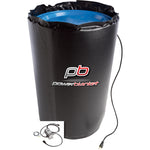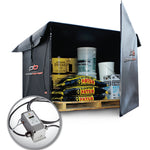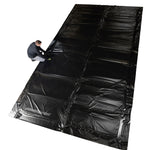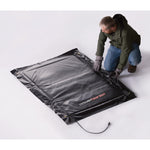You have no items in your shopping cart.
Article At-a-Glance
Can You Safely Use Heat Trace on PVC Pipes?
Yes, heat trace cables can be safely used on PVC pipes by selecting self-regulating models that prevent overheating, ensuring the temperature does not exceed PVC's melting point of 176°F (80°C), and following proper installation and maintenance practices to protect against freezing and damage.
Key Takeaways
- Select Self-Regulating Heat Trace Cables: Opt for self-regulating heat trace cables to prevent overheating and ensure safe use on PVC pipes, as they adjust heat output based on ambient temperature.
- Respect Temperature Limits: Always maintain temperatures below PVC's melting point of 176°F (80°C) to avoid pipe deformation or damage.
- Choose Compatible Heat Trace Models: Use heat trace systems specifically designed for non-metallic pipes like PVC to ensure compatibility and effectiveness.
- Follow Proper Installation Practices: Secure the heat trace cable directly to the PVC pipe, insulate properly, and connect to a power source with a thermostat for optimal performance and safety.
- Implement Regular Maintenance: Conduct routine inspections and tests to ensure the heat trace system is functioning correctly and to extend its lifespan, preventing freezing and damage in cold climates.
How Does Heat Trace Work for PVC Pipes?
In colder climates, PVC pipes often face formidable challenges as temperatures drop, leading to issues like freezing, cracking, and reduced flow rates. Fortunately, there's a proven solution that ensures optimal performance even in frigid conditions – heat trace. This article delves into the specifics of heat trace technology and why they’re an essential tool for warming PVC pipes.
Check out our custom page for Heat Trace solutions for businesses that can't afford to slow down, even in frigid weather.
What is Heat Trace?
Electric heat trace utilizes electrical cables or heating elements that run alongside the pipe. These cables generate heat when an electric current passes through them. Electric heat trace cable is versatile and can be used for various types of pipes and applications, making it suitable for both metallic and non-metallic pipes, such as PVC and CPVC.
Electric heat trace cable typically consists of a conductive core encased in insulation and a protective jacket. When energized, the cable generates heat, which transfers to the pipe, preventing the contents from freezing.
How heat trace works is widely known: it’s a reliable, cost-saving technology designed to counteract the adverse effects of cold temperatures on many applications. Without these cables, heating in cold weather usually involves bulky equipment using an external heat source to maintain a consistent temperature, which tends to be both expensive and inefficient. Heat trace, on the other hand, is low-cost and simple to install. The ease at which the cable prevents freezing, cracking, and other cold-induced issues makes it an obvious choice for those needing direct heat to ensure the seamless functioning of PVC pipes in chilly environments.

What are the Different Types of Heat Trace Cable?
Different types of heat trace systems are available, each tailored to specific needs. These include two types of electric heat trace: constant wattage heat trace and self-regulating heat trace. Understanding the principles behind each system is crucial for selecting the most suitable option for PVC pipes in various applications.
Here are two main types of electrical heat trace systems:
- Constant wattage: These systems provide a consistent level of heat output throughout their length.
- Self-regulating: These systems automatically adjust their heat output based on the surrounding temperature, providing more heat in colder areas and less heat in warmer areas. This helps to prevent overheating and conserve energy.
Constant Wattage vs Self-Regulating
For energy efficiency: If energy efficiency is a primary concern, self-regulating heat trace is generally preferred due to its ability to adapt and reduce heat output in warmer conditions.
For long runs: Constant wattage may be more suitable for long pipe runs where maintaining a consistent heat output is crucial.
For temperature variations: If your application involves temperature variations along the length of the pipe, self-regulating heat trace is often the better choice.
Ultimately, the "better" option depends on the specific needs of your application. Consulting with a heat trace system expert and considering factors such as pipe length, ambient temperature variations, and energy costs can help determine the most suitable solution for your particular situation.
How Does Heat Trace Work with PVC Pipes?
Heat trace can be paired with PVC pipes like ketchup is paired with french fries. Together, they make for a much better experience than PVC pipes alone.
PVC Pipes: Vulnerabilities and Needs
PVC pipes boast numerous advantages over metal piping like cost and lightweight material, but they also exhibit vulnerabilities in colder temperatures. Their susceptibility to freezing, cracking, and reduced flow rates can result in significant operational disruptions. Heat trace addresses these vulnerabilities and ensures PVC pipes remain robust and efficient, even in the harshest weather conditions.
Can You Put Heat Trace Directly on PVC Pipe?
Heat trace tape and cable can be placed directly on PVC pipe. This is one of the reasons heat trace is a highly effective solution for PVC pipes. Heat trace provides a reliable method for maintaining optimal temperatures and consistent heat, ensuring the seamless operation of PVC pipes. Heat trace mitigates the vulnerabilities of PVC pipes in cold environments, making it a practical and efficient solution for a range of industrial applications.
Can You Put Heat Trace on CPVC Pipe?
Heat trace systems can also be applied to CPVC (Chlorinated Polyvinyl Chloride) pipes. CPVC is known for its enhanced temperature resistance compared to standard PVC, but it may still encounter challenges in extremely cold conditions. Heat trace technology can be tailored to suit CPVC pipes, offering a reliable means of preventing freezing and maintaining optimal temperatures. The versatility of heat trace makes it adaptable to different pipe materials, ensuring that CPVC pipes can function efficiently and reliably in cold climates.
Benefits of Using Heat Trace for PVC Pipes
- Consistent Flow Rates: Maintaining consistent flow rates is vital for many industrial processes. Heat trace plays a crucial role in achieving this by keeping PVC pipes at the right temperature, thus preventing sluggish flow rates caused by cold-induced issues.
- Extended Pipe Lifespan: Freeze-thaw cycles can take a toll on PVC pipes, leading to wear and tear. Heat trace greatly reduces this threat, significantly extending the lifespan of PVC pipes and eliminating the need for frequent replacements.
- Low Cost: One of the primary benefits of heat trace for PVC pipes is how affordable heat trace can be. When compared to extensive heating systems that are built to warm entire warehouses, heat trace is a reliable, cost-efficient option.
Considerations When Choosing a Heat Trace System for PVC
Selecting the right heat trace system for PVC pipes requires careful consideration of various factors. The length of the pipes, ambient temperatures, and the desired temperature maintenance all play crucial roles in determining the most suitable solution. Additionally, evaluating power sources – such as electrical or solar-powered systems – ensures compatibility with specific applications and environmental conditions.
Consider the following:
- Pipe length: The length of the pipe will determine the amount of heat trace cable needed.
- Ambient temperatures: The temperature range in your area will determine the wattage rating of the cable needed.
- Desired temperature maintenance: The desired temperature range for the fluid within the pipes will influence the thermostat settings.
- Power source availability: You will need to choose a system that is compatible with your available power source, whether it be electrical or solar-powered.
It is always recommended to consult with a qualified professional to help you choose the right heat trace system for your specific needs and ensure proper installation.
How Hot Does It Have to Be to Melt PVC Pipe?
PVC pipes have a melting point of approximately 176°F (80°C). While PVC is known for its durability and resistance to heat, exceeding this temperature can result in deformation, softening, and potential melting of the material. It is crucial to use heat trace within their recommended temperature limits to avoid structural damage to the pipe.
How to Install Heat Trace on PVC Pipes
Installing a heat trace system on your PVC pipes is a relatively straightforward process. The specific steps may vary depending on the system you choose, but generally involve:
- Cleaning and preparing the pipe surface.
- Securing the heat trace cable to the pipe using straps or adhesive tape.
- Insulating the pipe to ensure efficient heat transfer.
- Connecting the cable to a power source.
- Connecting the heat trace with a thermostat (if applicable).
- Testing the system to ensure proper operation.
Once installed, heat trace systems operate automatically. The thermostat will monitor the temperature of the pipe and activate the heating cable when the temperature falls below the set point. This ensures that the pipes are maintained at the desired temperature without any manual intervention.

Maintenance and Longevity of Heat Trace Systems
To maximize the benefits of heat trace for PVC pipes, regular maintenance is essential. With proper care and maintenance, heat trace cable can provide many years of reliable service.
Follow the tips below for ensuring the longevity of heat trace systems, including proactive measures and addressing common issues that may arise over time:
- Regularly inspect the system for damage to the cable or insulation.
- Check connections and ensure they are secure and free of corrosion.
- Test the system periodically to ensure it is functioning properly.
- Keep the pipes and surrounding area clean and free of debris.
By following these simple maintenance tips, you can ensure that your heat trace system continues to protect your PVC pipes from the damaging effects of cold weather.
Heat Trace from Heat Authority
The efficiency, reliability, and cost-effectiveness of heat trace make it an indispensable asset for industries relying on PVC pipes for critical operations. Heat Authority has the equipment you need to explore the possibilities offered by heat trace technology, especially if you’re grappling with challenges during colder seasons. With heat trace electrical cable, as well as custom heating solutions, industries can ensure the seamless functionality of PVC pipes and unlock unparalleled operational efficiency.













